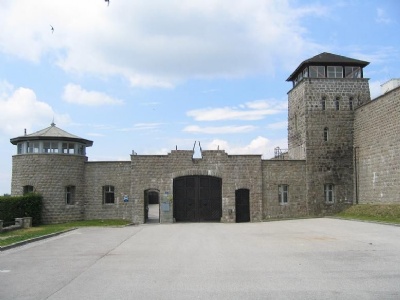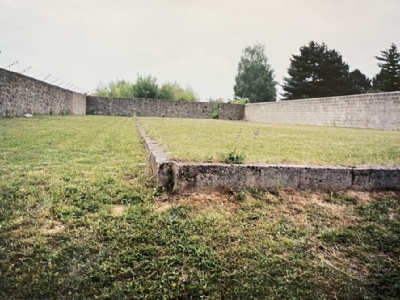Mauthausen
On March 11, 1938, Austria was occupied by Germany and incorporated into the German empire. Shortly afterward, SS chief, Heinrich Himmler, SS general Oswald Pohl and chief of the concentration camps, Theodor Eicke visited an existing quarry just outside a small village called Mauthausen, about ten kilometres southeast of Linz. The quarry was called Wienergraben and was located next to the river Danube. The purpose of the visit was to find a suitable place to set up a concentration camp for Austrian citizens. The German occupation of Austria was not welcomed by everyone and these must be kept under surveillance or even put in concentration camps.
At the end of April 1938, SS founded the company Deutsche Erd- und Steinwerke to extract granite from the quarry. The idea was that the labour needed would be taken from the concentration camp. In August 1938, about 3,000 prisoners were transferred from Dachau to Mauthausen to build the new camp. By the end of 1938, about 1,000 prisoners were imprisoned in the camp, mostly criminals and anti-socials. Shortly after the outbreak of war in 1939, the number of prisoners had increased to about 2600. The main purpose of the prisoners was to slave labor in the quarry next to the camp. The camp was also largely made up of stones from the quarry. The first commandant of the camp was SS-Hauptsturmführer, Albert Sauer, but he was replaced in February 1939 by SS-Sturmbannführer, Franz Ziereis, who remained in office until May 1945.
Mauthausen also consisted of some sixty satellite camps subordinated to Mauthausen’s organization. The most famous (and infamous) was Gusen about five kilometers west of Mauthausen. The satellite camps produced everything from war materials to building materials. The camp was placed in category 3, which meant that SS themselves considered it a camp with extreme harsh conditions. In Mauthausen there were also prison cells for prisoners who violated the camp rules. A crematorium and a smaller gas chamber was also built. There were also executions of prisoners. As in other camps, there was a lack of sanitary facilities, food shortage, lack of medicine, non-existent healthcare, overcrowding and the spread of diseases contributed to a high death rate among prisoners. Prisoners from all corners of Europe were sent to Mauthausen.
In 1942, the camp was given a gas wagon (truck with hermetically sealed cargo space) to murder prisoners. The truck went from Mauthausen and Gusen where the victims were cremated. Barely 3,000 prisoners deemed too ill to be used as slave labor were sent to nearby euthanasia centre Hartheim where they were murdered in its gas chamber. Mauthausen also conducted medical experiments on prisoners. SS doctor Aribert Heim is perhaps the most famous of them and in addition to experiments, he also murdered prisoners with lethal injections. He served only for about six weeks in the fall of 1941 before being transferred to Ebensee.
In 1944, the number of prisoners increased as a result of prisoners being sent to Mauthausen from evacuated camps closer to the front. One way to deal with the increased number of prisoners was to set up a tent camp just outside the camp. Here, mortality was extremely high because the availability of food and medicines was largely non-existent and extremely exposed to the weather. The camp was liberated by American troops on May 5, 1945. Of approximately 200,000 prisoners who ended up in Mauthausen between 1938 and 1945, about 100,000 died. Most often as a result of the slave labor they were forced to perform.
Current status: Partly preserved/demolished with museum (1998).
Address: Erinnerungsstrasse 1, 4310 Mauthausen.
Get there: Car.
Follow up in books: Kogon, Eugen: The Theory and Practice of Hell: The German Concentration Camps and the System Behind Them (2006).





























The camp is almost completely preserved and is in my opinion the best and most interesting after Auschwitz. Its rugged walls surrounding the camp give a medieval impression with evil premonitions. It contains several interesting exhibitions and is, as I said, well preserved, including the quarry. However, it seems that during my visit in 2024 the quarry can no longer be reached from the camp using the stone stair. Probably because the museum wants to preserve the stairs the prisoners used to go down and perform slave labor in the quarry. The quarry can still be visited if you take a different route and it is worth it.
In 2000, a concert of Vienna’s philharmonic orchestra performed Beethoven’s ninth symphony down in the quarry in memory of the victims. Although Austria was occupied by Germany, a large number of Austrian citizens became members of both the Nazi party and the SS. Several of the commanders and officers in the extermination camps were Austrian. This is problematic because it shows that Austria was not only a victim of Germany but also a state with a vast breeding ground for Nazism that other occupied countries didn’t have. It is doubtful whether Austria has examined itself as to why there was a great deal of support in Austria for Nazism.